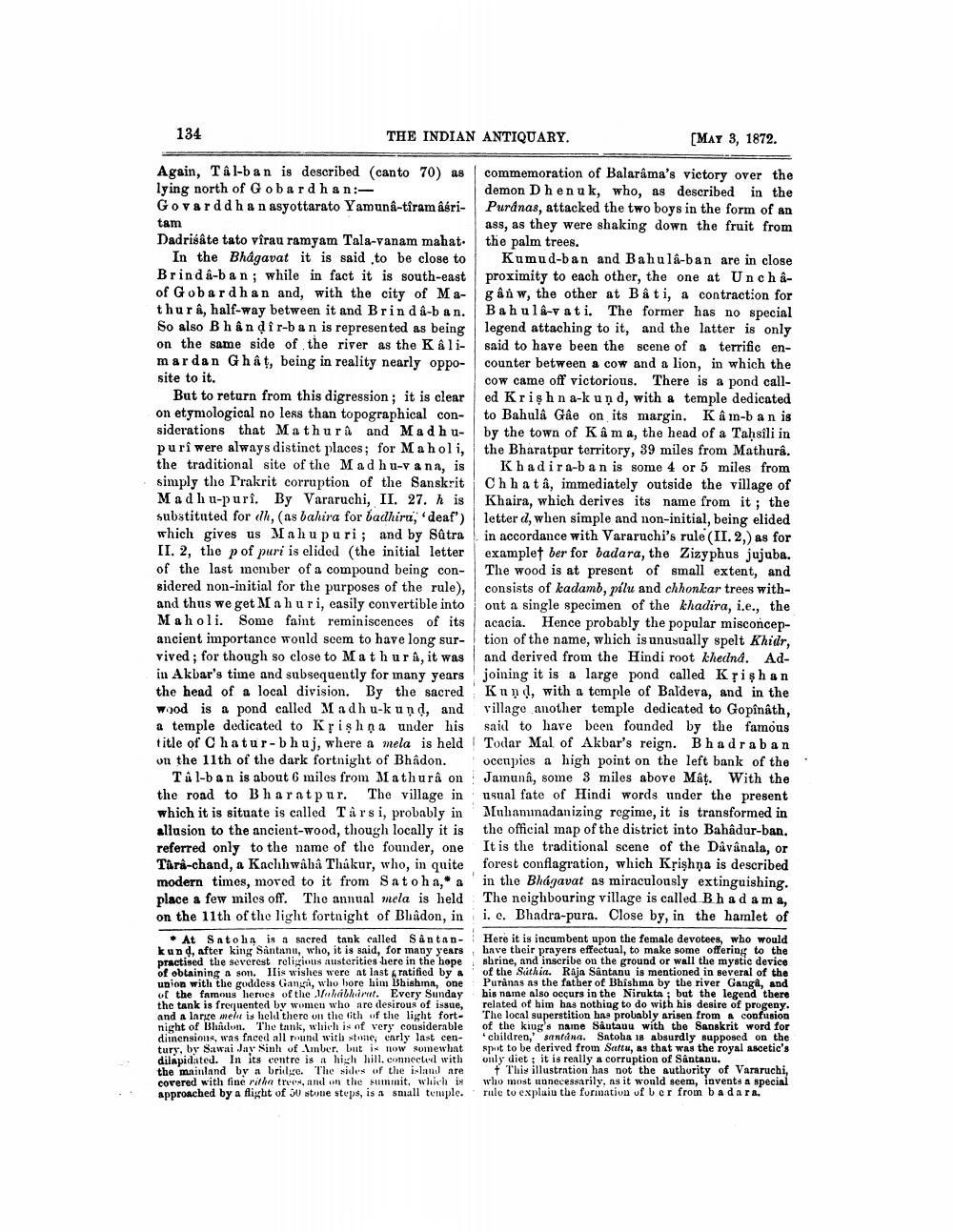________________
134
THE INDIAN ANTIQUARY.
Again, Tal-ban is described (canto 70) as lying north of Gobardhan:Govarddhanasyottarato Yamunâ-tîram âśri
tam
Dadrisâte tato virau ramyam Tala-vanam mahat. In the Bhagavat it is said to be close to Brindâ-ban; while in fact it is south-east of Gobardhan and, with the city of Mathurâ, half-way between it and Brinda-ban. So also Bhân dîr-ban is represented as being on the same side of the river as the Kâlimardan Ghat, being in reality nearly opposite to it.
But to return from this digression; it is clear on etymological no less than topographical considerations that Mathura and Madhupuri were always distinct places; for Maholi, the traditional site of the Madhu-vana, is simply the Prakrit corruption of the Sanskrit Madhu-puri. By Vararuchi, II. 27. h is substituted for dh, (as bahira for badhira, 'deaf') which gives us Mahupuri; and by Sûtra II. 2, the p of puri is elided (the initial letter of the last member of a compound being considered non-initial for the purposes of the rule), and thus we get Mahuri, easily convertible into Maholi. Some faint reminiscences of its ancient importance would seem to have long survived; for though so close to Ma t hurâ, it was in Akbar's time and subsequently for many years the head of a local division. By the sacred wood is a pond called Madhu-kund, and a temple dedicated to Krishna under his title of Chatur-bhuj, where a mela is held on the 11th of the dark fortnight of Bhâdon.
Tal-ban is about 6 miles from Mathurâ on the road to Bharatpur. The village in which it is situate is called Târsi, probably in allusion to the ancient-wood, though locally it is referred only to the name of the founder, one Tara-chand, a Kachhwâhâ Thakur, who, in quite modern times, moved to it from Satoha, a place a few miles off. The annual mela is held on the 11th of the light fortnight of Bhâdon, in
At Satoha is a sacred tank called Sântankund, after king Santanu, who, it is said, for many years practised the severest religious austerities here in the hope of obtaining a son. His wishes were at last ratified by a union with the goddess Ganga, who bore him Bhishma, one of the famous heroes of the Mahabharat. Every Sunday the tank is frequented by women who are desirous of issue, and a large mela is held there on the ith of the light fortnight of Bhadon. The tank, which is of very considerable dimensions, was faced all round with stone, early last century, by Sawai Jay Sinh of Amber, but is now somewhat dilapidated. In its centre is a high hill, connected with the mainland by a bridge. The sides of the island are covered with fine ritha trees, and on the summit, which is approached by a flight of 50 stone steps, is a small temple.
[MAY 3, 1872.
commemoration of Balarâma's victory over the demon Dhe nuk, who, as described in the Purdnas, attacked the two boys in the form of an ass, as they were shaking down the fruit from the palm trees.
Kumud-ban and Bahulâ-ban are in close proximity to each other, the one at Un châgân w, the other at Bâti, a contraction for Bahula-vati. The former has no special legend attaching to it, and the latter is only said to have been the scene of a terrific encounter between a cow and a lion, in which the cow came off victorious. There is a pond called Krishna-kund, with a temple dedicated to Bahulâ Gâe on its margin. Kâm-ban is by the town of K â m a, the head of a Tahsili in the Bharatpur territory, 39 miles from Mathura.
Khadira-ban is some 4 or 5 miles from Chhatâ, immediately outside the village of Khaira, which derives its name from it; the letter d, when simple and non-initial, being elided in accordance with Vararuchi's rule (II. 2,) as for examplet ber for badara, the Zizyphus jujuba. The wood is at present of small extent, and consists of kadamb, pílu and chhonkar trees without a single specimen of the khadira, i.e., the acacia. Hence probably the popular misconception of the name, which is unusually spelt Khidr, and derived from the Hindi root khedná. Adjoining it is a large pond called Krishan Kund, with a temple of Baldeva, and in the village another temple dedicated to Gopînâth, said to have been founded by the famous Todar Mal of Akbar's reign. Bhadraban occupies a high point on the left bank of the Jamunâ, some 3 miles above Mât. With the usual fate of Hindi words under the present Muhammadanizing regime, it is transformed in the official map of the district into Bahâdur-ban. It is the traditional scene of the Dâvânala, or forest conflagration, which Krishna is described in the Bhagavat as miraculously extinguishing. The neighbouring village is called Bhadama, i. c. Bhadra-pura. Close by, in the hamlet of
Here it is incumbent upon the female devotees, who would have their prayers effectual, to make some offering to the shrine, and inscribe on the ground or wall the mystic device. of the Sathia. Raja Sântanu is mentioned in several of the Puranas as the father of Bhishma by the river Ganga, and his name also occurs in the Nirukta; but the legend there related of him has nothing to do with his desire of progeny. The local superstition has probably arisen from a confusion of the king's name Sâutauu with the Sanskrit word for 'children, santana. Satoha 18 absurdly supposed on the spot to be derived from Sattu, as that was the royal ascetic's only diet; it is really a corruption of Sântanu.
f This illustration has not the authority of Vararuchi, who most unnecessarily, as it would seem, invents a special rule to explain the formation of ber from ba dara.




